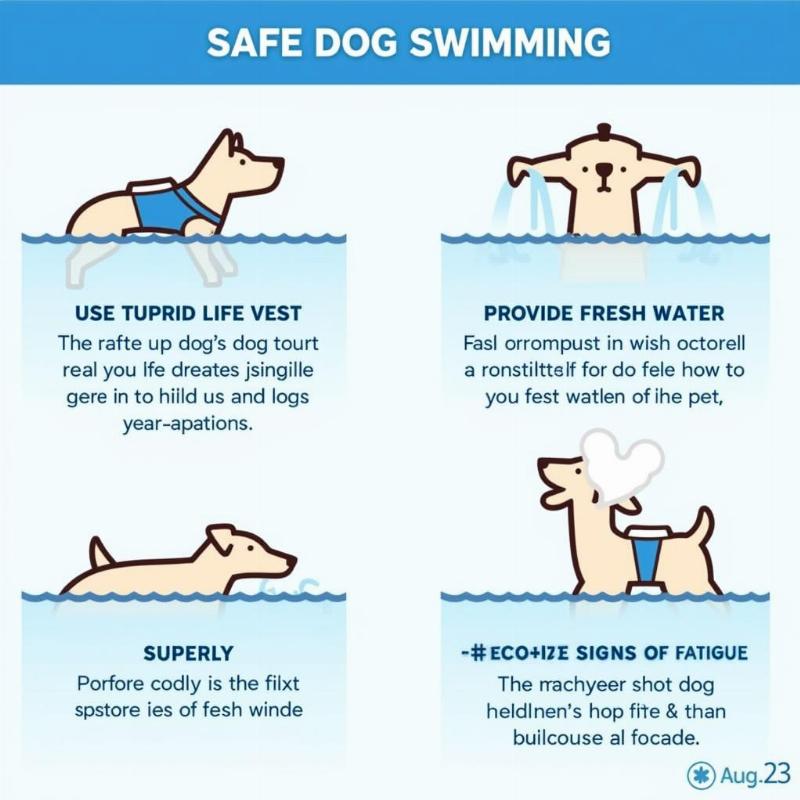Swimming is a popular activity for many dogs, offering a great way for them to exercise and cool off, especially during the hot summer months. But how long can our canine companions actually stay in the water? The answer isn’t a simple one-size-fits-all. Several factors influence a dog’s swimming endurance, and understanding these is crucial for ensuring their safety and enjoyment.
Factors Affecting a Dog’s Swimming Time
Just like humans, not all dogs are created equal when it comes to swimming. Breed, age, physical condition, and even the water temperature play a significant role in determining how long a dog can comfortably and safely swim.
Breed Predisposition
Some breeds, like Newfoundlands, Portuguese Water Dogs, and Labrador Retrievers, are naturally gifted swimmers, bred for water retrieval and rescue. Their webbed feet, water-resistant coats, and strong bodies allow them to stay afloat and swim for extended periods. Other breeds, such as Bulldogs, Dachshunds, and Pugs, with their short legs, brachycephalic (short-nosed) features, and dense bodies, may struggle in the water and tire quickly.
Age and Physical Condition
A young, healthy dog with plenty of energy will generally be able to swim for longer than a senior dog or one with underlying health issues. Just like us, older dogs can experience arthritis and muscle weakness, making swimming more strenuous. Similarly, dogs with heart or respiratory problems should only swim for short periods, under close supervision.
Water Temperature
Cold water can quickly sap a dog’s body heat, leading to hypothermia. Even strong swimmers can become fatigued and disoriented in cold water. Conversely, while warm water might seem ideal, extended exposure to hot sun and warm water can lead to heatstroke. Always consider the water temperature and weather conditions before letting your dog swim for any length of time.
Signs of Doggy Paddle Fatigue
It’s crucial to recognize the signs that your dog is getting tired in the water. Watch for:
- Heavy panting: This is one of the first signs of exertion.
- Slowed swimming: A dog that’s tiring will start to slow down and may struggle to keep its head above water.
- Tilted head: If your dog’s head is tilted far back, it’s likely struggling to breathe.
- Whining or whimpering: These vocalizations can indicate distress.
- Glazed eyes or disorientation: These are signs of severe fatigue and potential hypothermia.
If you see any of these signs, immediately remove your dog from the water.
Tips for Safe Swimming with Your Dog
- Start slow: Introduce your dog to the water gradually, allowing them to acclimate at their own pace. Never force a dog into the water.
- Use a life vest: Even strong swimmers can benefit from a life vest, especially in open water or strong currents. A heavy duty reflective dog collar can also enhance visibility and safety, even during water activities.
- Supervise closely: Never leave a swimming dog unattended, no matter how experienced they are.
- Provide fresh water: Swimming can be dehydrating, so ensure your dog has access to fresh drinking water.
- Limit swimming time: Start with short swimming sessions and gradually increase the duration as your dog’s stamina improves. Consider a spray for ticks on dogs after swimming, especially in wooded or grassy areas.
- Know your dog’s limits: Pay attention to your dog’s individual swimming ability and adjust the activity accordingly.
 Safe Dog Swimming Tips
Safe Dog Swimming Tips
Conclusion
How long a dog can swim depends on a variety of factors. While some breeds are natural water lovers, others may struggle. By understanding your dog’s individual needs and limitations, and by following safe swimming practices, you can help ensure that swimming remains a fun and enriching activity for both of you. Remember, a tired dog is a vulnerable dog, so always prioritize their safety and well-being.
FAQ
- Do all dogs instinctively know how to swim? Not all dogs are natural swimmers. Some breeds require more assistance and training.
- Is it okay to let my dog swim in a chlorinated pool? Chlorine can irritate a dog’s skin and eyes. Rinse your dog thoroughly after swimming in a chlorinated pool.
- What should I do if my dog seems scared of the water? Never force a dog into the water. Use positive reinforcement and gradual introduction to help them become comfortable.
- Can I take my dog swimming in the ocean? Yes, but be aware of strong currents and tides. Always use a life vest and supervise closely.
- How can I help my dog build up its swimming stamina? Start with short swims and gradually increase the duration and distance.
- What are the best dog breeds for swimming? Breeds like Newfoundlands, Labrador Retrievers, and Portuguese Water Dogs are known for their swimming abilities. Are you interested in are golden retrievers good hunting dogs?
- Is it safe for puppies to swim? Puppies can swim, but they tire easily and should be supervised closely.
Related Articles
We couldn’t find any related articles on our site at this time.
About Beautdogs.us
Beautdogs.us is your premier online destination for all things dog-related in the US. We provide expert advice on dog breeds, care, training, and product reviews. Whether you’re a seasoned dog owner or just starting your journey with a furry companion, Beautdogs.us offers comprehensive resources to help you navigate the world of dog ownership. We are committed to providing reliable and up-to-date information to enhance the lives of dogs and their owners across America. Contact us today for more information: Email: [email protected], Phone: +1 501-555-7529.